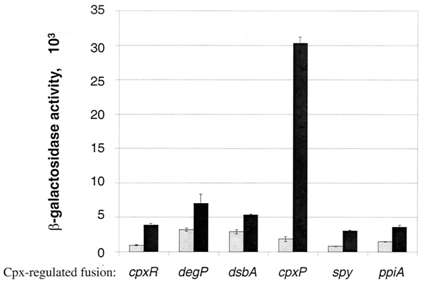Team:Calgary/Project/CpxP
From 2010.igem.org
| Line 83: | Line 83: | ||
<span id="bodytitle"><h1>Cpx Circuits</h1></span> | <span id="bodytitle"><h1>Cpx Circuits</h1></span> | ||
| + | <br/> | ||
| - | + | <img src="http://i872.photobucket.com/albums/ab287/iGEMCalgary_2010/cpxp-1.png"></img> | |
| - | </ | + | <br/> |
| + | <img src="http://i872.photobucket.com/albums/ab287/iGEMCalgary_2010/cpxr-1.png"></img> | ||
| + | <br/> | ||
| + | <img src="http://i872.photobucket.com/albums/ab287/iGEMCalgary_2010/degp-1.png"></img> | ||
<p> | <p> | ||
The circuit that will be constructed to detect protein misfolding will have the cpxP promoter. Two other similar circuits will be constructed to compare the activation of cpxP promoter compared to degP and cpxR promoter. All three promoters have the same function: activation of degP which degenerates misfolded proteins in the cell. As it can be seen in the graph below, the cpxP promoter is the most sensitive to the stress. | The circuit that will be constructed to detect protein misfolding will have the cpxP promoter. Two other similar circuits will be constructed to compare the activation of cpxP promoter compared to degP and cpxR promoter. All three promoters have the same function: activation of degP which degenerates misfolded proteins in the cell. As it can be seen in the graph below, the cpxP promoter is the most sensitive to the stress. | ||
The purpose of this circuit is to detect protein misfolding. For example, cpxP promoter becomes activated under several specific streses: elevation of pH and overexpression envelope proteins such as NlpE. Hence, if periplasmic misfolding occurs in the cell of an E.coli bacteria, the reporter gene, in this case the Red Fluroscent Protein (RFP), will be activated. Hence, the activation of the RFP will be the indication of a periplasmic protein misfolding. | The purpose of this circuit is to detect protein misfolding. For example, cpxP promoter becomes activated under several specific streses: elevation of pH and overexpression envelope proteins such as NlpE. Hence, if periplasmic misfolding occurs in the cell of an E.coli bacteria, the reporter gene, in this case the Red Fluroscent Protein (RFP), will be activated. Hence, the activation of the RFP will be the indication of a periplasmic protein misfolding. | ||
</p> | </p> | ||
| + | <br/> | ||
| + | |||
</html>[[Image:DegP Cpx Project Figure.png|thumb|400px|left|DiGuiseppe, P.A., & Silhavy, T.J. (2003). Signal detection and target gene induction by the cpxra two-component system. Journal of Bacteriology, 185(8), 2436-2436.]]<html> | </html>[[Image:DegP Cpx Project Figure.png|thumb|400px|left|DiGuiseppe, P.A., & Silhavy, T.J. (2003). Signal detection and target gene induction by the cpxra two-component system. Journal of Bacteriology, 185(8), 2436-2436.]]<html> | ||
Revision as of 01:05, 27 October 2010

Cpx Circuits



The circuit that will be constructed to detect protein misfolding will have the cpxP promoter. Two other similar circuits will be constructed to compare the activation of cpxP promoter compared to degP and cpxR promoter. All three promoters have the same function: activation of degP which degenerates misfolded proteins in the cell. As it can be seen in the graph below, the cpxP promoter is the most sensitive to the stress. The purpose of this circuit is to detect protein misfolding. For example, cpxP promoter becomes activated under several specific streses: elevation of pH and overexpression envelope proteins such as NlpE. Hence, if periplasmic misfolding occurs in the cell of an E.coli bacteria, the reporter gene, in this case the Red Fluroscent Protein (RFP), will be activated. Hence, the activation of the RFP will be the indication of a periplasmic protein misfolding.
 "
"
